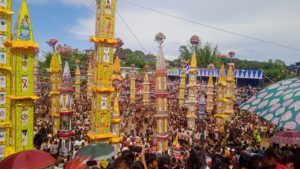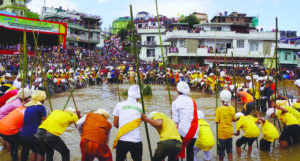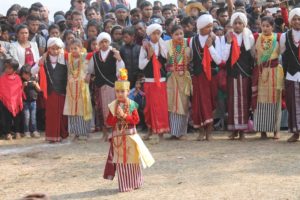Dr. Omarlin Kyndiah
The myth of Niaw Wasa or HynniewTrep is central to the Jaintia and Khasi identities. The extended version of the myth is widely known in Jaintia Hills. Their religion, Ka Niam, which also doubles as a code of social conduct draws from the myth of Hynniewtrep or U Niaw 
Advent of Behdenkhlam
Wasa. However, the myth of U Lakriah further tells the people about the rules of religious and social conduct, which are ‘God given’ through U Syiem Lakriah, who established order in the society by declaring the commandments’. U Syiem Lakriah is God’s emissary, the bearer of his commandments.
Dance as a form of religious devotion is a cherished, and universal norm. Evidence for it in prehistory is provided by cave paintings. The first proof of the existence of dance came from the 9000-year-old cave paintings in India which described the celebration, drinking, and dancing of tribe members after a successful hunt. These dance performances were soon adopted into early religions, often serving as a very effective way to describe various myths, legends, and astronomical events. In many traditions, dance functioned as a medium of prayer and praise, as an expression of joy and reverence, and as a mediator between God and humanity. Thus, this understanding of dance permeated the faith of many religious groups.
Behdeinkhlam
Niam Behdeinkhlam is the religious festival of the Jaintia tribe of Meghalaya. Behdienkhlam had its origins in invoking the presence of God through a dance that in the earlier period was known as Ka Chad Soo Sngi Le Yaw.
Gradually, it underwent a change when Cholera or ka Khlam prai pynhiar broke out in the plains of Jaintiapur (in Sylhet) and spread to the hills of the Jaintia Kingdom causing havoc to its inhabitants. Hence, keeping all the religious connotations intact it was “during the ensuing annual festival, prayers were offered to U Tre-Kirot to cast off the disease and soon it was called Ka Behdienkhlam. Hence, the term Behdeinkhlam is derived from the Jaintia words “Beh ” meaning to chase away; “Dein ” is a tree, and “Khlam ” is understood as plague, famine, or epidemic.
In Niam Behdeinkhlam the rituals are connected to the myth of U Lakriah and the descent of U Niaw Wasa through Ka Tangnoob Tangjri (the golden ladder). During the festival, the community members are reminded of their Golden Age through the myth of U Lakriah. Prof. Soumen Sen in his book Between Tradition and Change states, ” The parable of U Sohpetbneng and U Lum Diengiei are to be read along with the legend of U Syiem Lakriah… What the legend of U Lakriah emphasizes is that when the golden ladder was removed and the people lost contact with God and heaven, darkness fell on the earth signifying a crisis in the people’s life but on prayer, contact with God was restored and God ordained that his wish would be communicated through U Lakriah, the Syiem, whose divine character made him the leader of the people and thus the order was restored. It was through U Lakriah the divine commandments or Niam were communicated”.
The myth of U Lakriah points to the rules of religious and social conduct which are handed to U Niaw Wasa by U Tre Kirot (God) through U Lakriah. The story of the origin of Niam Behdeiñkhlam is part of the origin myth connected with the appearance of the Jaintias and Khasis in their present location. Thus Behdeinkhlam religious festival is part of the kinship and belief systems of the Jaintia and Khasi communities. The myth of U Syiem Lakriah tells how U Lakriah became the first chief and introduced the religious commandments or Niam as desired by U Tre Kirot. Hence their religion is known as Niamtre.
To celebrate the settlement of Niaw Wasa on earth, the Niam Behdeiñkhlam is performed. It symbolizes reverence and thanksgiving to God, the creator. The rites and rituals performed during the festival are eventually directed towards the veneration of legendary ancestors like U Syiem Lakriah and the four progenitrix, Ka Bon, Ka Teiñ, Ka Wet, and Ka Doh. Prayers are offered to God invoking Him to drive away all the evil spirits. Sacrifices are made to Ki Blai Chnong Blai Raid invoking them to protect from natural calamities and prevent the people from famine and diseases. Prayers are also offered to Ka Bei Rymaw for a bountiful harvest. During the festival, ‘ritual food’ offered to the ancestors (Ki Sangia Ki Saret) signifies a means to communicate with gods and ancestors who are invisibly present with their families during the four days of this religious festival. Behdeiñkhlam is an occasion that brings the Niaw Wasa closer to God and it also explains the concept of the creation of a community and its religion – Niamtre. Since Behdeinkhlam is usually celebrated during the high monsoon and after sowing, rites, and rituals are also performed to drive away the evil spirits of plague and pestilence. This is a natural practice of the agrarian society.
The Colonial Policy
Daw man! Daw man! Myn da wan kichong Laban,
Chynrang Khynthai wa io luti yei sur ka bom ka bhuri
Daw man! daw man! myn da wan kichong Laban
(It will happen! It will happen! When Laban (Shillong) people come,
Boys and girls are looking forward to the sound of drums and flute
It will happen! It will happen! When Laban people come)
From 1931 to 1947, the British banned Behdeiñkhlam, causing discontent among the people. The above lines are from a song, celebrating the revival of the festival.
Two men quarreled during the festival. The British took advantage of this situation and issued an order to ban Behdeiñkhlam.” The hidden agenda was the suppression of Jaintia indigenous customs and religious traditions. It was a golden opportunity for them to interfere in an internal matter of the Jaintias. Jaintia Community in the face of such intrusion, decided in a meeting convened at the local durbar hall of Iongpiah locality during the last years of colonial rule in the presence of community stalwarts from Shillong like U Harrison Kyndiah, U Pati Laloo, U Sahon Roy Lanong and U Pati Rangad that the community should reclaim their freedom of expression and rights to worship.
Chiphiah or Laho Dance
Chad Chiphiah or Laho Dance is also said to have originated by God’s grace. The genesis of Chad Chiphiah is traced to the myth of U Syiem Lakriah and the descent of U Niaw Wasa through ka Tangnoob Tangjri (the golden ladder). One of God’s (U Tre Kirot) desires is to send U Niaw Wasa (seven huts) to earth through the golden ladder to live and prosper happily. God selected a leader, U Syiem Lakriah, and bestowed him with divine qualities to maintain contact with Him on behalf of Niaw Wasa. U Tre Kirot appeared before U Lakriah in the form of a rainbow. The Rainbow is a symbolic bridge to the divine, a sign of God’s covenant. It is a symbol of peace and hope. However, this literalism is not universal. In many cultures, a rainbow is an evil presence- dangerous to even point at.
When God made the earth, no life was yet in it except rocks, water, and air. There was no soil which was essential for cultivation. Therefore, Niaw Wasa was unhappy. They told Syiem Lakriah that in such a barren place they could not build their huts and could not cultivate. God, therefore, put the earth in order. First, He instructed the goddess, Ka Bei Rymaw (Earth Mother) to give three baskets of soil known as ‘ka le khoh le sun’ to make the earth cultivable and productive. Thus the earth became green. U Lakriah follows God’s instructions to perform libation rituals (ka suit ka choor) to seek for himself which dance would please the Creator. Libation is a means of communicating with the Supreme Being, the lesser divinities, and the ancestors. As a prayer, it is primarily directly addressed to the Supreme Being. In the first instance, U Lakriah offered a couple dance, where a male and a female partner in a dance (Ka Chad Chijur). In the parable of Ka Krem Lamet Ka Krem Latang, a day was fixed for a dance by all living creatures to glorify God, until the Sun and Moon, who were sister and brother descended to the earth to dance together. This act is considered a brother-sister relationship. It’s a story that explores the dark world of the taboo. In essence, the couple’s dance is not acceptable. U Lakriah then performs another libation ritual to seek divine sanction for the triplet dance, where a female and two males participate in the dance, known as Chad Chiphiah.
In Chiphiah Dance the female who represents the custodian of the family is flanked by two males one to her right and the other to the left. The male to the right and left symbolize the maternal uncle and father respectively. The lone female dancer signifies the chief priestess or Ka Langdoh.
For countless years, Chiphiah Dance was not performed. The story of its revival dates back to 1917. According to Mr. Baliro Nikhla, at some point in the past, lived at Jwai, a woman named Ka Riang Nikhla who possessed divine qualities. At the time of her death, she disappeared into a place called Chahtngit. Since then the Nikhla clan regarded her as a deity and is now known as Ka Weipun Riangkit. Speaking in tongues, also referred to as the gift of tongues or glossolalia, is a phenomenon that occurs when a person experiencing religious ecstasy or a trance utters incomprehensible sounds that they believe are a language spoken through them by a god or deity. In Jaintia this phenomenon is known as ‘hiar chwar or hiar blai’. This tradition is still practiced in Jaintia Hills. Weipun Riangkit in her Chwar reminded the elder of Jwai the need to revive the Chad Chiphiah. Hence, Chad Chiphiah was performed at the premises of U Sing Nikhla at Chilliang Raij, Jwai. Since then, Chiphiah Dance is also known as ‘Chad Nikhla’.
In cultures all across the globe, dancing is integral to both community celebration and the expression of spiritual life. In the context of the supernatural origin of Niaw Wasa or Hynniewtrep , the myth of U Syiem Lakriah and the Origin of Behdeinkhlam and Laho Dance functioned as a medium of prayer and praise, as an expression of joy and reverence, and as a mediator between God and humanity. Behdeinkhlam and Laho Dance are the two ritualistic events related to the myth of the origin of Niaw Wasa or Hynniewtrep.




